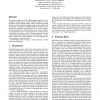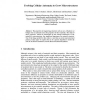367 search results - page 41 / 74 » Captive Cellular Automata |
CA
2003
IEEE
14 years 29 days ago
2003
IEEE
We present a simple, linear 3D cellular automata approach for animating the melting process of solid volumetric models. Accurate modelling of object melting usually requires compl...
EUROGP
2003
Springer
14 years 26 days ago
2003
Springer
The properties of engineering structures such as cars, cell phones or bridges rely on materials and on the properties of these materials. The study of these properties, which are d...
EH
2002
IEEE
14 years 18 days ago
2002
IEEE
Fluid flow in porous media is a dynamic process that is traditionally modeled using PDE (Partial Differential Equations). In this approach, physical properties related to fluid fl...
GPEM
2007
13 years 7 months ago
2007
Cancer is an evolutionary process; mutated cells are selected for abnormal growth and survivability. Here, a computer simulation is used to model ductal carcinoma in situ (DCIS), ...
RAS
2006
13 years 7 months ago
2006
Self-reconfigurable robots are built from modules, which are autonomously able to change the way they are connected. Such a robot can, through this self-reconfiguration process, c...


